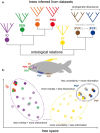Assessing Bayesian Phylogenetic Information Content of Morphological Data Using Knowledge From Anatomy Ontologies
- PMID: 35285502
- PMCID: PMC9558846
- DOI: 10.1093/sysbio/syac022
Assessing Bayesian Phylogenetic Information Content of Morphological Data Using Knowledge From Anatomy Ontologies
Abstract
Morphology remains a primary source of phylogenetic information for many groups of organisms, and the only one for most fossil taxa. Organismal anatomy is not a collection of randomly assembled and independent "parts", but instead a set of dependent and hierarchically nested entities resulting from ontogeny and phylogeny. How do we make sense of these dependent and at times redundant characters? One promising approach is using ontologies-structured controlled vocabularies that summarize knowledge about different properties of anatomical entities, including developmental and structural dependencies. Here, we assess whether evolutionary patterns can explain the proximity of ontology-annotated characters within an ontology. To do so, we measure phylogenetic information across characters and evaluate if it matches the hierarchical structure given by ontological knowledge-in much the same way as across-species diversity structure is given by phylogeny. We implement an approach to evaluate the Bayesian phylogenetic information (BPI) content and phylogenetic dissonance among ontology-annotated anatomical data subsets. We applied this to data sets representing two disparate animal groups: bees (Hexapoda: Hymenoptera: Apoidea, 209 chars) and characiform fishes (Actinopterygii: Ostariophysi: Characiformes, 463 chars). For bees, we find that BPI is not substantially explained by anatomy since dissonance is often high among morphologically related anatomical entities. For fishes, we find substantial information for two clusters of anatomical entities instantiating concepts from the jaws and branchial arch bones, but among-subset information decreases and dissonance increases substantially moving to higher-level subsets in the ontology. We further applied our approach to address particular evolutionary hypotheses with an example of morphological evolution in miniature fishes. While we show that phylogenetic information does match ontology structure for some anatomical entities, additional relationships and processes, such as convergence, likely play a substantial role in explaining BPI and dissonance, and merit future investigation. Our work demonstrates how complex morphological data sets can be interrogated with ontologies by allowing one to access how information is spread hierarchically across anatomical concepts, how congruent this information is, and what sorts of processes may play a role in explaining it: phylogeny, development, or convergence. [Apidae; Bayesian phylogenetic information; Ostariophysi; Phenoscape; phylogenetic dissonance; semantic similarity.].
© The Author(s) 2022. Published by Oxford University Press on behalf of the Society of Systematic Biologists.
Figures






References
-
- Arendt D. 2008. The evolution of cell types in animals: emerging principles from molecular studies. Nat. Rev. Genet. 9:868–882. - PubMed
-
- Arendt D., Musser J.M., Baker C.V., Bergman A., Cepko C., Erwin D.H., Pavlicev M., Schlosser G., Widder S., Laubichler M.D., Wagner G.P.. 2016. The origin and evolution of cell types. Nat. Rev. Genet. 17:744–757. - PubMed
-
- Bandelt H.J., Dress A.W.. 1992. Split decomposition: a new and useful approach to phylogenetic analysis of distance data. Mol. Phylogenet. Evol. 1:242–252. - PubMed
Publication types
MeSH terms
Associated data
LinkOut - more resources
Full Text Sources
Other Literature Sources

